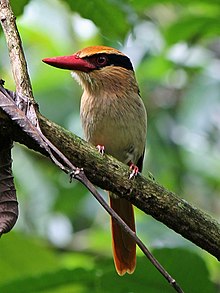The Sulawesi lilac kingfisher (Cittura cyanotis) is a species of kingfisher in the genus Cittura, found in the lowlands of the Indonesia island of Sulawesi and Lembeh.
| Sulawesi lilac kingfisher | |
|---|---|

| |
| male | |

| |
| female | |
| Scientific classification | |
| Domain: | Eukaryota |
| Kingdom: | Animalia |
| Phylum: | Chordata |
| Class: | Aves |
| Order: | Coraciiformes |
| Family: | Alcedinidae |
| Subfamily: | Halcyoninae |
| Genus: | Cittura |
| Species: | C. cyanotis
|
| Binomial name | |
| Cittura cyanotis (Temminck, 1824)
| |

Taxonomy
editThe specific epithet cyanotis is from classical Greek kuanos for "dark blue" and "-ōtis" for "eared".[2] The first formal description of the Sulawesi lilac kingfishers were by the Dutch zoologist Coenraad Jacob Temminck in 1824 under the binomial name Dacelo cyanotis.[3][4]
Description
editIt has the typical kingfisher shape, with a short tail and long bill. The adult male has a brown crown and back and rufous rump and tail. It has a blue eye mask, separated from the crown by a white line, and a pale lilac ruff of long stiffened ear covert feathers. The underparts are white and the wings are blue, separated by a white line from the brown back. The red bill is large and flattened. In flight, the underwings are white with a black "wrist" patch.[5]
The call is a rapid ku-ku-ku-ku.[5]
Behaviour
editThe Sulawesi lilac kingfisher is found in lowland rainforest and drier hill forest up to 1,000 m (3,300 ft) altitude.[5]
It perches motionless on a low branch watching for its prey, mainly large insects, on the ground below. Little else is known of the behaviour of this species, and no nests have been found.[5]
Status
editThis species has a restricted range and fragmented distribution, and is uncommon, with no records from south Sulawesi. Lowland deforestation has been extensive in recent decades, and the loss of its habitat has led to lilac kingfisher being classed as near-threatened.
Gallery
edit-
At Mt. Mahawu (1100 mdpl)
-
Cittura cyanotis at Bintauna, North Bolaang Mongondow
-
Sulawesi lilac kingfisher in Tangkoko Nature Reserve, Sulawesi
References
edit- ^ BirdLife International. (2016). "Cittura cyanotis". IUCN Red List of Threatened Species. 2016: e.T22726889A94934825. doi:10.2305/IUCN.UK.2016-3.RLTS.T22726889A94934825.en. Retrieved 19 November 2021.
- ^ Jobling, James A. (2010). The Helm Dictionary of Scientific Bird Names. London: Christopher Helm. pp. 110, 128. ISBN 978-1-4081-2501-4.
- ^ Temminck, Coenraad Jacob (1838) [1824]. Nouveau recueil de planches coloriées d'oiseaux, pour servir de suite et de complément aux planches enluminées de Buffon (in French). Vol. 4. Paris: F.G. Levrault. Plate 262 text. The 5 volumes were originally issued in 102 parts, 1820-1839.
- ^ Peters, James Lee, ed. (1945). Check-list of Birds of the World. Vol. 5. Cambridge, Massachusetts: Harvard University Press. p. 192.
- ^ a b c d Fry, C. Hilary; Fry, Kathie; Harris, Alan (1992). Kingfishers, Bee-eaters, and Rollers. London: Christopher Helm. pp. 122–123. ISBN 978-0-7136-8028-7.
